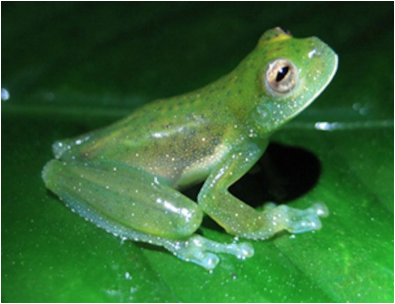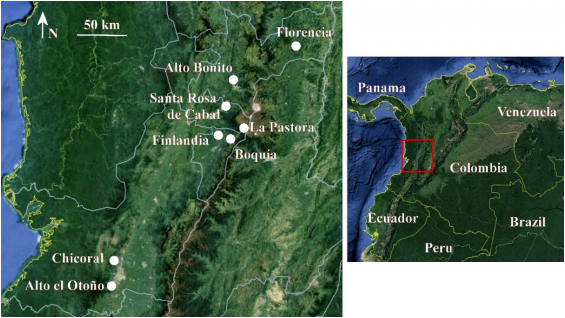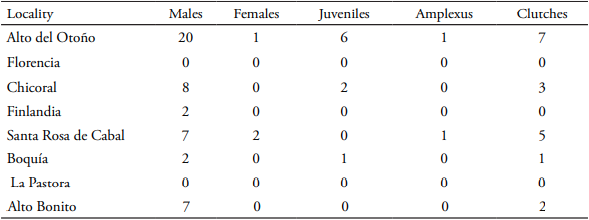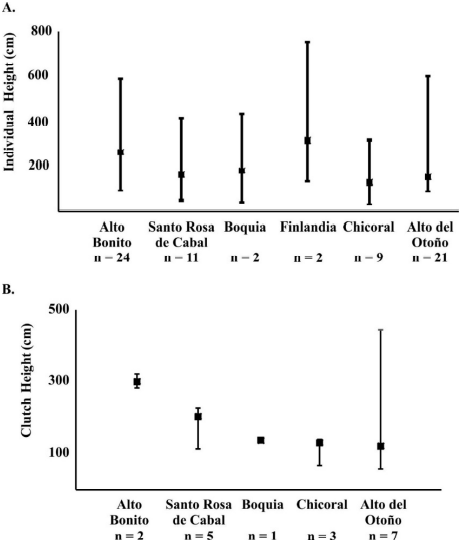Introduction
The Centrolenidae family is a clade of anurans, commonly known as glassfrogs, endemic to the Neotropical region, that inhabits from southern Mexico through Central America and into South America mainly through the Andes Cordillera from Venezuela to Bolivia, with species in the Amazon and Orinoco River basins, the Guyana Shield Region, eastern Brazil, and northern Argentina (Frost, 2017). Considerable advances in phylogenetic knowledge of the family Centrolenidae have been achieved (Cisneros-Heredia and McDiarmid, 2003; 2004), but the natural history, ecology, and conservation status of most species are virtually unknown.
Currently, 74 out of the 153 species of glassfrogs have been reported in Colombia (Amphibia web, 2017). One of this is Centrolene savagei (Ruíz and Lynch, 1991), an endemic species to Colombia that is characterized by a small body size, green dorsum with dark green and white dots, rounded snout when viewed dorsally, and lack of humeral spine. Since 2004, this species has been listed by IUCN as vulnerable (Castro-Herrera and Bolivar-García, 2010, Bolívar-García et al., 2013; IUCN, 2017; Vargas-Salinas et al., 2017), being mainly affected by the clearing of forests for agriculture and by environmental pollution (Blaustein and Kiesecker, 2002; Bolivar-Garcia et al., 2013).
Centrolene savagei (Fig. 1) has been reported from the Central and Western Andes of Colombia, in some locations of the departments of Antioquia, Quindío, Risaralda, Caldas, Tolima and Valle del Cauca (Ruíz-Carranza and Lynch, 1991; Cadavid et al., 2005; Vargas-Salinas et. al., 2007; Castro-Herrera and Vargas-Salinas, 2008; Guayasamin et al., 2008; Luna-Mora, 2011; Rojas-Morales et al., 2011; Escobar-Lasso and Rojas-Morales, 2012; Díaz-Gutiérrez et al., 2013). However, population sizes have not been estimated yet although this is a main ecological index in order to determine the conservation status of a species. In this paper, we used capture-recapture techniques in order to estimate the population size of Centrolene savagei population in the localities where it has been previously registered and we report the results of observations about the height of perches of males and females of this specie in the study sites.
Materials and Methods
Capture-recapture data were collected in eight field trips carried out between October 2012 and June 2013 to eight different localities in the Western and Central Andes of Colombia (Fig. 2, Table 1). Each field trip lasted 3 days and every study area was sampled three consecutive days. In each locality, a 500 m transect was established along a creek, and a visual encounter survey was conducted at night by two observers 6 h hours during night, and 3 h during daylight. The effective effort was equivalent to 54 hours in each study area.
Table 1 Sampling localities. Lat: latitude, Lon: Longitude, E: Elevation (m above sea level), P: mean precipitation (mm/year), T: mean temperature (°C)

All individuals detected were marked with a consecutive number using the toe clipping techniques. A recapture history for each locality was assembled from the subsequent surveys. Considering the short sampling time, we assumed closed population conditions and used the adjusted Lincoln-Petersen model (NB) in order to estimate the population size. This estimation was only carried out in the localities where the recapture was positive, and the population size record was used in order to define the Centrolene savagei density in each study area as individuals per hectare.
Finally, each captured individual was sexed through physical observations of characteristics such as size and buccal slips, and the height above water level of the perch was registered. Furthermore, all detected clutches in each transect were marked with a consecutive number/ and the height above water level was recorded. In order to search individuals and clutches at heights above 3 m, four ascent stations were set up along each transect, and ascent equipment was used to reach heights up to 6 meters above the ground.
Results
A total of 49 adult individuals (46♂ and 3♀), 9 juveniles, 18 egg clutches, and 2 amplexus were registered during this study. However, at La Pastora and Florencia, no individuals of Centrolene savagei were found (Table 2). The highest number of individuals marked was in Alto el Otoño (21 individuals) and the lowest was in Filandia and Boquía (2 individuals). The standardized amount of individuals and clutches of Centrolene savagei found per hour during the sampling effort was among 0.25 (Alto el Otoño) and of 0.09 (Finlandia and Boquía).
Only at Alto del Otoño, Chicoral, and Santa Rosa de Cabal recapture was present. The estimate population size in the Alto del Otoño was 132 ± 13 individuals (density = 440 ± 43 Ind/ha), followed by the population found at Chicoral with 41 ± 8 individuals (density = 137 ± 27 Ind/ha), and the last one found at Santa Rosa de Cabal with 37 ± 6 individuals (density = 123 ± 20 ind/ha). No recaptures occurred at Filandia, Boquía or Alto Bonito. Therefore, no estimation of population size at these localities could be done.
Adult individuals were found between 59 and 445 cm above water level, with a mean height of 182.5 ± 78.6 cm and female individuals were found between 114 to 124 cm above water level (Fig. 3A). Egg clutches were found at the same height range, with a mean height of 180.7 ± 99.9 cm (Fig. 3B).
Discussion
This study provides the first quantitative assessment of population metrics of C. savagei in six localities of Colombia. Baseline population vital rates, including density, survival, and population growth rates are critical for determining extinction risk and population trends. Mark-recapture studies are a particularly robust method for determining population vital rates and can be used to monitor changes through time (Cole et al., 2014). Although, long term monitoring is essential to accurately distinguish drivers of population dynamics, assess extinction risk and rigorously estimate population parameters (Pechmann et al., 1991; Bonebrake et al., 2010), some authors like Funk et al. (2003) and Cole et al. (2014) have suggested that short-term capture-recapture analysis, assuming closed populations, is a good method for monitoring density of small frogs over time.
Our result suggests that some sites (e.g., Alto el Otoño, Chicoral and Santa Rosa de Cabal) may be capable of supporting larger breeding populations and thus have greater conservation value for this endemic species. However, no presence records in some locations (e.g., Florencia and Ucumari) where it had been previously recorded (Ruíz and Lynch, 1991; Rojas-Morales et al., 2011; Prado-Sañudo et al., 2018) suggests that the species could have been extinguished from those areas, that the population size is so small that it requires a greater sampling effort in order to determine their occurrences, or that the local conditions of these areas were not the proper ones for the reproduction of the species, decreasing the chance of visual encounters.
Unfortunately, the low rate of recaptures only allowed estimating the population size at three locations: Alto del Otoño, Chicoral, and Santa Rosa. Populations of Filandia, Boquía and Alto Bonito require a higher sampling effort in order to achieve a population estimate and be able to draw more accurate conclusions. However, a positive record of C. savagei in all of these locations, suggest that local biotic and abiotic conditions are enough for sustaining individuals of this species. Otherwise, the low rate of recaptures could be associated with a low detectability of C. savagei in the study zones. It is usually common in complex and heterogeneous systems, such as tropical forests, and may derive from a cryptic coloration of C. savagei, sex behavior patterns or with a seasonal reduced individual foraging activity and reproduction (Haddad and Giaretta, 1999; Ruíz-Gutierrez and Zipkin, 2011; Kajin and Grelle, 2012; Maritz and Alexander, 2012).
The range height of perching between 1.5 - 2 m tend to provide favorable conditions to reduce predation by small terrestrial mammals on individuals or eggs. However, it does not represent a risk to the survival of tadpoles because of the impact when they hit the water (Hampton and Otto, 2014; Cisneros-Heredia and Guayasamin, 2014). Females usually stay at a higher level within the forest (Restrepo and Naranjo, 1999; Quintero-Ángel et al., 2008), reducing drastically their detectability by traditional sampling methods. However, it is important to emphasize that, despite the ascents made with the equipment (reaching heights of up to 6 meters), no females of the species were found between 2.0-6.0 meters high, suggesting that females preferred perches above 6 m height, getting down only for reproduction, that they usually migrate to the inner part of the forest, or that other sampling techniques are required in order to improve the results.
The presence of C. savagei in 75% of the localities where it had previously been reported suggests that the biotic and abiotic conditions in these sites are still adequate to sustain populations of this endemic species. With this study, we were able to report the size and density of the C. savagei in three sites of the Alto del Otoño, Chicoral and Santa Rosa de Cabal. In Filandia, Boquía and Alto Bonito it is required to increase the sampling effort in order to define the C. savagei vital rates. At two locations, Florencia and La Pastora, where this species has been previously recorded, it seems that it is no longer there. However, further studies are needed in order to determine the complete absence of the species at these localities.


















